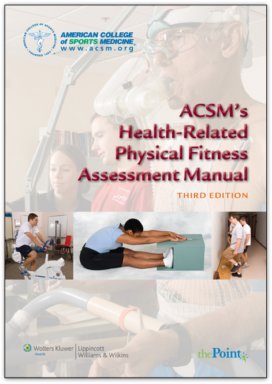|
|
Exercise ACSM's Health-Related Physical Fitness Assessment Manual |  | Item | : | 9780781797719 | | Pub Date | : | June 2009 | | Edition | : | Third | | Pages | : | 224 | | Illustrations | : | 52 | | Cover | : | Softbound | | Trim Size | : | 7" x 10" (17.8 x 25.4 cm) | | Author | : | American College of Sports Medicine |
From the American College of Sports Medicine (ACSM), this text provides the information necessary to develop skills for assessing an individual's health-related physical fitness. It provides a practical "how-to-do-it" approach for performing assessment skills effectively, and an understanding of the theory behind and the importance of each skill or assessment. The Third Edition includes updated references to ACSM's Guidelines for Exercise Testing and Prescription, Eighth Edition, more diagrams and pictures highlighting assessment techniques, and new material on physical activity assessments, considerations for medication usage, and common measurement errors.
A companion Website includes an Image Collection, a Test Generator, and PowerPoint Slides.
Table Of Contents
CHAPTER 1 Introduction
- Defining Health-related Physical Fitness
- Components of Health-related Physical Fitness
- The Importance of Measuring Health-related Physical Fitness
- The Relationship of Physical Fitness to Health
- The Relationship of Physical Fitness to Function
- Fundamental Principles of Assessment
- The Physical Fitness Professional
- References
CHAPTER 2 Pre-Assessment Screening
- Rationale for Preassessment Screening
- Informed Consent
- Objective: Risk Stratification
- Other Health Issues to Consider
- Summary
- Laboratory Activities
- Risk Stratification Using a Comprehensive Health History Questionnaire
- Risk Stratification Using the AHA/ACSM Health/Fitness Facility
- Preparticipation Screening Questionnaire
- Administering an Informed Consent
CHAPTER 3 Risk Factor Assessments
- Resting Blood Pressure
- Blood Test
- Obesity
- Physical Activity
- Other Diseases and Conditions
- Summary
- Laboratory Activities
- Resting Blood Pressure Assessment
- Body Mass Index Assessment
- International Physical Activity Questionnaire Assessment
CHAPTER 4 Body Composition
- Why Measure Body Composition?
- What Is the Gold Standard Test?
- Clinical Measures
- Tests of Body Volume
- Anthropometry
- Bioelectrical Impedance Analysis
- Interpretation
- Estimation of Goal Body Weight
- Laboratory Activities
- Skinfold Estimation of Body Fat Percentage
CHAPTER 5 Muscular Fitness
- Unique Assessment Principles
- Muscular Fitness Continuum
- Strength Assessments
- Endurance Assessments
- Interpretation Issues
- Laboratory Activities
- Assessment of Muscular Strength
- Muscular Endurance Assessment
CHAPTER 6 Flexibility
- Flexibility as a Component of Health-related
- Physical Fitness
- Unique Assessment Principles
- Methods of Measurement
- Distance Tests for Assessment of Flexibility
- Range of Motion Defined
- Goniometers-Tools to Measure Range of Motion
- Range-of-motion Assessment Overview
- Interpretation
- Laboratory Activities
- Range-of-motion Assessments
- Distance Tests for Flexibility Assessment
CHAPTER 7 Cardiorespiratory Fitness: Estimation from Field and Submaximal Exercise Tests
- Why Measure Cardiorespiratory Fitness?
- What Is the Gold Standard Test?
- Pretest Standardizations for Cardiorespiratory Fitness Assessments
- Field Tests for Prediction of Aerobic Capacity
- Submaximal Exercise Tests
- Interpretation
- Summary
- Laboratory Activities
- Field Test Assessments of Cardiorespiratory Fitness
- Submaximal Exercise Test Assessments of Cardiorespiratory Fitness
CHAPTER 8 Cardiorespiratory Fitness: Maximal Exercise Testing
- Risks
- Monitoring
- Personnel
- Selecting the Mode for Testing
- Protocols
- Test Procedures
- Measured and Estimated V.O2max
- Interpretation
- Summary
- Laboratory Activities
- Maximal Exercise Tests
- Appendix A Conversions
- Appendix B Forms
- Index
|
|
|
| Call 1-888-321-3979 (toll free) or 816-728-3979 | Ordering Information | Copyright © 2008-2009 AnatomicallySpeaking.com |
|
|
|

